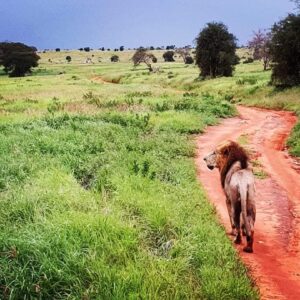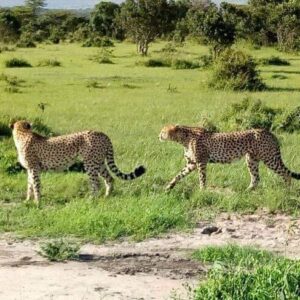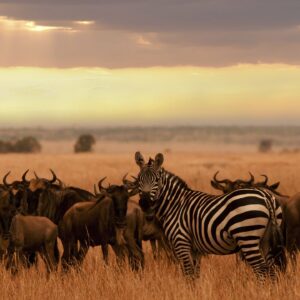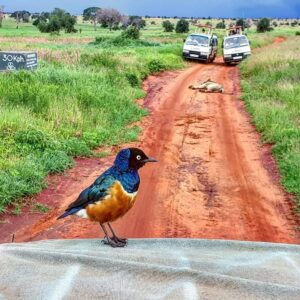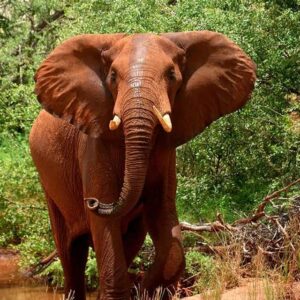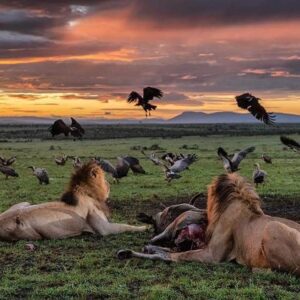“World's Greatest Show”
A Kenya safari showcasing ‘The Greatest Wildlife Show on Earth’
World renowned for the breathtaking spectacle of ‘the greatest wildlife show on earth’ , the awe inspiring annual wildebeest migration, the Masai Mara National Reserve is Kenya’s most visited wildlife protected area. Technically an extension of Tanzania’s renowned Serengeti National Park, the Mara constitutes only 4% of the entire Serengeti ecosystem but its rolling grasslands, meandering rivers and towering escarpments offer one of the world’s most rewarding and evocative African safari wildlife arenas.
Wildlife Safari: Fact File
Altitude: 1,500-2,170 meters above sea level.
Area: 1, 672 sq km.
Location: Rift Valley Province, Narok and Transmara Districts.
Distance from Nairobi: 270 km.
Gazetted: the Mara Triangle, a 520 sq km area between the Siria Escarpment, the Tanzania border and the Mara River was declared a National Game Reserve in 1948 and brought under the control of Narok County Council in 1961. It attained its present size in 1995.
Mara Safari Climate: the Reserve receives the highest rainfall (average 1000 mm pa) in the Serengeti-Mara ecosystem. Rain falls throughout the year but peaks in December, January and April.
Kenya Mara Vegetation: comprises open rolling grassland, riverine forest, acacia woodland, swamps, non-deciduous thickets, and Acacia, Croton and Tarchonanthus scrub.
Wildlife: the Mara ecosystem hosts over 95 species of mammals.
Birds: more than 550 recorded species (5 globally threatened).
Roads: main roads and major tracks are usually navigable with 2WD during the dry seasons, but 4WD is recommended during the rainy seasons.
Safari lodge options: Popular lodges include the Sarova Mara, the Serena Safari Lodge Mara, Governors Camp, Keekorok, Kichwa Tembo and numbers numerous Mara Camp, luxury safari and safari lodge options
What is a National Reserve?
National Reserves are areas where wildlife is protected and takes precedence over human activities, but where human habitation and domestic livestock is also permitted. Most of Kenya’s National Reserves (with the exception of Marsabit and the Shimba Hills, both of which are administered by KWS) are administered by their local authorities. The Mara is administered jointly by Narok and Trans Mara Country Councils, while security personnel from KWS and the Kenya Police operate from permanent posts around the Reserve.
What’s in a name?
The gazetted name of the National Reserve is the Masai Mara, but it is also referred to as the Maasai Mara. Both spellings are correct but Maasai is more correctly used when referring to the Maasai people. In the Maa language, the common tongue of the il-Maasai clans, the word Mara means ‘spotted’ and is thought to refer to the patchy mosaic of bushes and trees that define the Mara plains.
About the Reserve
The Mara is divided into four topographical units: the Ngama Hills to the east of Keekorok and the Sekanani Gate; the Siria Escarpment, which forms the western boundary; the Mara Triangle, which lies between the Mara River and the Siria Escarpment; and the Central Plains, which lie between the Mara River and the Ngama Hills. The permanent Mara and Talek Rivers and their tributaries flow through the Reserve.
Arena for ‘the greatest wildlife show on earth’
Between the end of July and November, over one and a half million wildebeest accompanied by half again as many zebras and gazelles, migrate from the short-grass plains of the Serengeti to fresh pasture in the grasslands of the Mara; thus creating one of nature’s grandest spectacles. Moving in groups of up to 20,000 at a time they thunder across the plateau hesitating only briefly to cross the Mara River, where many fall prey to the waiting crocodiles. Towards the end of October they begin crossing back into Tanzania. The actual timing of the migration, however, is dictated by the weather and does not always run to schedule.
Did you know? That the migration is a comparatively recent phenomenon, prior to 1969 only a few wildebeest spilled over from the Serengeti in exceptionally dry years.
Predator paradise
Offering an abundance of herbivores, the Mara makes the ideal hunting ground for Kenya’s famous ‘big cats’ and hosts her largest population of lions. It also offers the best chance of spotting a leopard in the wild. Other predators include cheetah and spotted hyena.
The rest of the wildlife cast
Historically teaming with wildlife, the Mara is famous for the large herds of elephant and buffalo that meander its plains; also for the fat pods of hippo that wallow in its mud-brown rivers. Other stars include the distinctive Masai giraffe, plum-coloured topi, Coke’s hartebeest, Grant’s and Thomson’s gazelle, zebra, impala, Kirk’s dik-dik, bushbuck, waterbuck and red duiker. The Reserve also boasts plentiful Nile crocodile, monitor lizard, baboon, vervet, blue and red-tailed monkeys, nocturnal bush babies, and tree hyrax.
One of Kenya’s most important bird areas
Boasting over 550 resident and migratory species, the Mara shelters an incredible array of both regionally and globally threatened birds. Easily spotted on the plains are the common ostrich, secretary bird, ground hornbill and bustard (Kori, black-bellied and white-bellied). Also plentiful are crowned plover, red-necked spur fowl and helmeted guinea fowl, while along the rivers African fish eagle, Egyptian geese, yellow-billed stork, sacred ibis and blacksmith plover abound. The Reserve also boasts 53 species of raptors, to include augur buzzard, black-shouldered kite, bateleur eagle and 6 species of vulture. The Reserve is the only place in Kenya where you can see the rare Schalow’s turaco.
Of golden plains and scattered flowers
The Mara’s plains are dominated by Themeda triandra (red oat grass) and following the rains the lush grasslands burst briefly into brilliance with a glorious array of small flowering plants, such as the charming pink, orange or mango-coloured Crossandra subacaulis , the so-called ‘tissue paper flower’ (Cycnium tubulosum ), the stunning fire ball lily (Scadoxus multiflorus ) and the glorious pink and white striped pyjama lily (Crinum macowanii ).
What to do
The Mara offers a broad range of pursuits to include cultural sites and villages, day and night game drives and daytime guided walks (just outside the Reserve), and spectacular early morning hot-air balloon flights.
